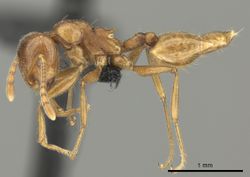Key to Crematogaster degeeri species assemblage workers
This worker key is based on: Blaimer, B.B. & Fisher, B.L. 2013. Taxonomy of the Crematogaster degeeri-species-assemblage in the Malagasy region (Hymenoptera: Formicidae). European Journal of Taxonomy 51: 1-64 (DOI 10.5852/ejt.2013.51).
You may also be interested in
- Key to Crematogaster species groups of the Malagasy region
- Key to Crematogaster degeeri species assemblage queens
- Crematogaster degeeri assemblage
- Ants of Madagascar
- Crematogaster
- Crematogaster subgenus
1
- Propodeal spines absent, reduced to small tubercules or denticles, or short triangular spines with SPI < 0.07; if very rarely propodeal spines spiniform and longer (SPI 0.08-0.10), then small species (HW 0.72-0.88, WL 0.79- 0.91), color dirty-yellow, montane rainforest habitats . . . . . 2
- Propodeal spines longer, distinctly spiniform and SPI > 0.07; size and color variable; all habitats . . . . . 9
2
return to couplet #1
- Eyes small (OI < 0.21) and largely confluent with lateral head margin . . . . . 3
- Eyes larger (OI > 0.20) and distinctly protruding from lateral head margin . . . . . 6
3
return to couplet #2
- Pronotum dorsally with a distinct median longitudinal groove, medium to large species (HW 0.98-1.43, WL 0.98-1.48) . . . . . Crematogaster mafybe
- Pronotum dorsally without median longitudinal groove, size variable . . . . . 4
4
return to couplet #3
- Propodeum with spines absent or at most small tubercules (SPI 0.00) . . . . . Crematogaster lobata
- Propodeum with short triangular spines or sharp minute denticles . . . . . 5
5
return to couplet #4
- Antennal scapes very short (SI 0.67-0.75), not reaching head margin; mesonotum usually with posterolateral denticles . . . . . Crematogaster masokely
- Antennal scapes variable, but usually longer (SI 0.69-0.82) and about reaching head margin; mesonotum usually without posterolateral denticles . . . . . Crematogaster dentata (in part - also #7) (in part - also #13)
6
return to couplet #2
- Eyes very large (OI 0.24-0.29), situated above midline of head in full-face view; antennal scapes mostly longer (SI 0.77-0.87), reaching or surpassing head margin; bicolored: head and thorax yellowish to dark orange, metasoma with A4-7 brown or black . . . . . Crematogaster sewellii
- Eyes mostly smaller (OI 0.20-0.26), usually situated at midline of head in full-face view; antennal scapes variable, but often shorter (SI 0.69-0.83), just about or not reaching head margin; color variable . . . . . 7
7
return to couplet #6
- Propodeum usually distinctly set off from promesonotum in lateral view and often with posterolateral denticles; promesonotum with sparse erect pilosity ( < 8 setae); petiole often much wider than long (PTWI 1.18-1.52), and strongly flared . . . . . 8
- Propodeum not distinctly set off from promesonotum (in lateral view), never with distinct posterolateral denticles; promesonotum usually with abundant erect pilosity (>8 setae); petiole not much wider than long (PTWI 0.95-1.31), moderately flared . . . . . Crematogaster dentata (in part - also #5) (in part - also #13)
8
return to couplet #7
- Medium-sized species (HW 0.86-1.03, WL 0.92-1.08); propodeal spines short and triangular (SPI 0.03-0.07); pronotum with sharp lateral margins . . . . . Crematogaster malahelo
- Small species (HW 0.72-0.88, WL 0.79-0.91); propodeal spines longer (SPI 0.06-0.10); pronotum lacking sharp lateral margins . . . . . Crematogaster alafara
9
return to couplet #1
- Body color dirty to bright yellow . . . . . 10
- Predominant color either orange, brown or black . . . . . 11
10
return to couplet #9
- Medium to large species (HW 0.87-1.03, WL 0.98-1.22); antennal scapes very long (SI 0.91-1.01), easily surpassing head margin . . . . . Crematogaster bara
- Small species (HW 0.60-0.86, WL 0.66-0.93); antennal scapes short (SI 0.71-0.83), not or about reaching head margin . . . . . Crematogaster maina
11
return to couplet #9
- Head distinctly broader than long (CI 1.10-1.19); propodeal spines longer (SPI 0.10- 0.26); tricolored: orange-red, yellow and black . . . . . Crematogaster tricolor
- Head not much broader than long (CI 1.01-1.13); propodeal spines shorter (SPI < 0.16); uniformly colored or bicolored . . . . . 12
12
return to couplet #11
- Mesonotum often with posterolateral denticles (Fig. 5C); in lateral view distinctly set off from propodeum (Fig. 5C); eyes large (OI 0.22-0.26); propodeal spines longer (SPI 0.10-0.16); erect pilosity on promesonotum often sparse ( < 8 long erect setae) (as e.g. Figs 5C) . . . . . Crematogaster degeeri
- Mesonotum variable, but more often without posterolateral denticles, and thus in lateral view not as distinctly set off from promesonotum (Fig. 5D); erect pilosity usually more abundant ( > 8 long erect setae) (as in Fig. 5D, E); propodeal spines shorter (SPI < 0.12) . . . . . 13
13
return to couplet #12
- Propodeum with a distinct short dorsal face, and with a transverse impression (Fig. 5E); sculpture on pronotum carinulate or reticulate (Fig. 5E); petiole oval, fairly slender; (PTWI 0.95-1.14); propodeal spines longer (SPI 0.07-0.12) . . . . . Crematogaster ramamy
- Propodeum usually without a distinct dorsal face, never with transverse impression (Fig. 5F); sculpture on propodeum rugulose or aciculate (Fig. 5F); petiole variable, but often wider (PTWI 0.95-1.31); propodeal spines usually shorter (SPI 0.01-0.10) . . . . . Crematogaster dentata (in part - also #5) (in part - also #7)




















